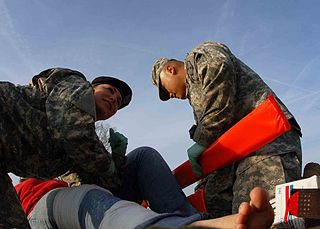 W
WA cochlear implant (CI) is a surgically implanted neuroprosthesis that provides a person who has bilateral moderate-to-profound sensorineural hearing loss with sound perception and an opportunity with therapy for improved speech understanding in both quiet and noisy environments. A CI bypasses acoustic hearing by direct electrical stimulation of the auditory nerve. Through everyday listening and auditory training, both children and adults may learn to interpret those signals as speech and sound.
 W
WEmergency medical responders are people who are specially trained to provide out-of-hospital care in medical emergencies. There are many different types of emergency medical responders, each with different levels of training, ranging from first aid and basic life support. Emergency medical responders have a very limited scope of practice and have the least amount of comprehensive education, clinical experience or clinical skills of emergency medical services (EMS) personnel. The EMR program is not intended to replace the roles of emergency medical technicians or paramedics and their wide range of specialties. Emergency medical responders typically assist in rural regions providing basic life support where pre-hospital health professionals are not available due to limited resources or infrastructure.
 W
WA partial lunar eclipse took place on March 13, 1979, the first of two lunar eclipses in 1979. The Moon was strikingly shadowed in this deep partial eclipse which lasted 3 hours, 17 minutes and 40.6 seconds, with 85.377% of the Moon in darkness at maximum.
 W
WA total lunar eclipse took place on September 6, 1979, the second of two lunar eclipses in 1979. A shallow total eclipse saw the Moon in relative darkness for 44 minutes and 24.7 seconds. The Moon was 9.358% of its diameter into the Earth's umbral shadow, and should have been significantly darkened. The partial eclipse lasted for 3 hours, 11 minutes and 54.1 seconds in total.
 W
WAn annular solar eclipse occurred on August 22, 1979. A solar eclipse occurs when the Moon passes between Earth and the Sun, thereby totally or partly obscuring the image of the Sun for a viewer on Earth. An annular solar eclipse occurs when the Moon's apparent diameter is smaller than the Sun's, blocking most of the Sun's light and causing the Sun to look like an annulus (ring). An annular eclipse appears as a partial eclipse over a region of the Earth thousands of kilometres wide. A small annular eclipse covered only 93% of the Sun in a very broad path, 953 km wide at maximum, and lasted 6 minutes and 3 seconds. This was the second solar eclipse in 1979, the first one a total solar eclipse on February 26.
 W
WA total solar eclipse occurred in North America on February 26, 1979.
 W
WThe Vela incident, also known as the South Atlantic Flash, was an unidentified double flash of light detected by an American Vela Hotel satellite on 22 September 1979 near the Prince Edward Islands in the Indian Ocean.